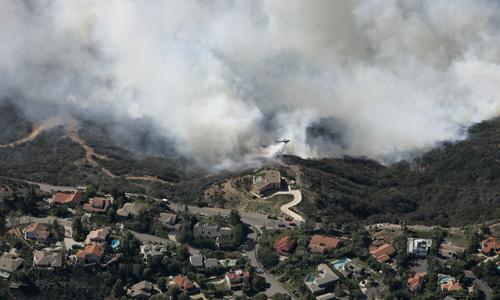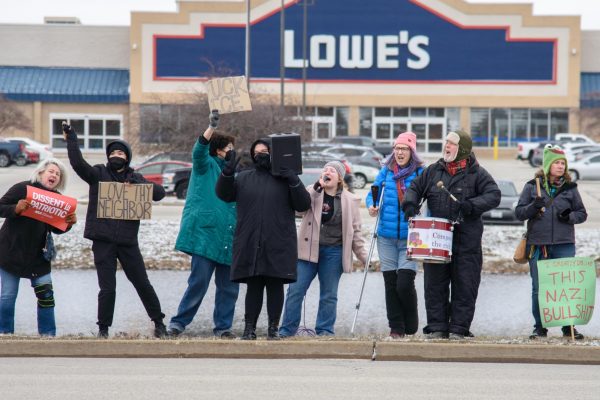Wildfires take toll on California

A firefighting helicopter makes a water drop over Malibu, Calif, on Monday. About 1,500 people were evacuated Monday. THE ASSOCIATED PRESS, CHRIS CARLSON
Oct 23, 2007
Last updated on May 12, 2016 at 05:41 p.m.
SAN DIEGO – Wildfires blown by fierce desert winds Monday reduced scores of Southern California homes to ashes, forced hundreds of thousands of people to flee and laid a hellish, spidery pattern of luminous orange over the drought-stricken region.
At least one person was killed in the fires, and dozens were injured. Nearly 130 homes had burned in one mountain town alone, and thousands more buildings were threatened by more than a dozen blazes covering at least 310 square miles.
“The sky was just red. Everywhere I looked was red, glowing. Law enforcement came barreling in with police cars with loudspeakers telling everyone to get out now,” said Ronnie Leigh, 55, who fled her home at a mobile home park as flames darkened the sky over the nearby ridge line.
Firefighters – who lost valuable time trying to persuade stubborn homeowners to leave – were almost completely overwhelmed as gale-force winds gusting to 70 mph scattered embers on the dry brush. California officials pleaded for help from fire departments in other states.
Get The Daily Illini in your inbox!
A pair of wildfires consumed 128 homes in the mountain resort community of Lake Arrowhead, in the San Bernardino National Forest east of Los Angeles, authorities said.
“We’re stretched very thin and we can’t get any planes up,” said forest spokesman John Miller.
At least 14 fires were burning in Southern California, said Patti Roberts, a spokeswoman for the Governor’s Office of Emergency Services.
More than 265,000 people from Malibu to San Diego were warned to leave their homes. More than 250,000 were told to flee in San Diego County alone, where hundreds of patients were moved by school bus and ambulance from a hospital and nursing homes, some in hospital gowns and wheelchairs. Some carried their medical records in large zip-lock plastic bags.
A 1,049-inmate jail in Orange County was evacuated because of heavy smoke. The prisoners were taken by bus to other lockups.
At San Diego’s Qualcomm Stadium, home to the NFL’s Chargers, thousands of people huddled in eerie silence on the bleachers, staring at muted TV news reports of the wildfires. A lone concession stand served coffee and doughnuts.
Many evacuees gathered in the parking lot with their pets, which were banned from the stadium.
San Diego County fires were burning so fast that authorities did not have an accurate count of how many homes had been destroyed.
“It was nuclear winter. It was like Armageddon. It looked like the end of the world,” Mitch Mendler, a San Diego firefighter, said as he and his crew stopped at a shopping center parking lot to refill their water truck from a hydrant near a restaurant. Asked how many homes had burned, he said, “I lost count.”
The blazes in San Diego County and elsewhere erupted one after another over the weekend. Things got worse Monday, when several new fires erupted and other fires merged. Parts of seven Southern California counties were ablaze.
All San Diego police officers and detectives were ordered to return to work to help move people to safety and handle other fire-related emergencies.
Gov. Arnold Schwarzenegger declared a state of emergency in the seven affected counties, opening the way for government aid.
Associated Press writers Chelsea J. Carter and Jeremiah Marquez in Los Angeles, Jacob Adelman in Santa Clarita and Elliot Spagat in San Diego contributed to this report.





